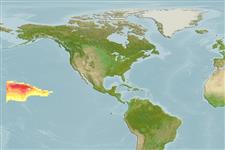Klassifizierung / Names
Namen | Synonyme | Catalog of Fishes (gen., sp.) | ITIS | CoL | WoRMS | Cloffa
Actinopterygii (Strahlenflosser) >
Stomiiformes (Lightfishes and dragonfishes) >
Stomiidae (Barbeled dragonfishes) > Melanostomiinae
Etymology: Eustomias: Greek, eu = good + Greek, stoma = mouth (Ref. 45335).
Lebensraum / Klimazone / Range
Ökologie
; seewasser; tiefenbereich 0 - 70 m (Ref. 11333). Tropical, preferred ?
Eastern Central Pacific: off Oahu, Hawaii.
Size / Gewicht / Alter
Maturity: Lm ? range ? - ? cm
Max length : 10.9 cm SL Männchen/unbestimmt; (Ref. 11333)
Kurzbeschreibung
Morphologie | Morphometrie
Rückenflossenweichstrahlen (insgesamt): 26; Afterflossenweichstrahlen: 38; Wirbelzahl: 68. Two terminal bulbs separated by a very long distance, 2.4 times length of distal bulb. Barbel 66% SL. Proximal bulb not centered in stem, extending externally and bearing 3 slender filaments, the longest reaching end of distal bulb. Distal bulb 1.5 times proximal-bulb length with an intermediate branch. Axis of stem between bulbs and in filament densely pigmented. External chevron-shaped or rounded striated areas unpigmented except near base of stem. Middorsal paired spots between occiput and dorsal-fin origin 8 (Ref. 11333).
Life cycle and mating behavior
Geschlechtsreife | Fortpflanzung | Ablaichen | Eier | Fecundity | Larven
Gibbs, R.H. Jr., T.A. Clarke and J.R. Gomon, 1983. Taxonomy and distribution of the stomioid fish genus Eustomias (Melanostomiidae), I: subgenus Nominostomias. Smithson. Contrib. Zool. 380:139 p. (Ref. 11333)
IUCN Rote Liste Status (Ref. 115185)
CITES (Ref. 94142)
Not Evaluated
Bedrohung für Menschen
Harmless
Nutzung durch Menschen
Mehr Information
NamenSynonymeMetabolismusRäuberÖkotoxikologieFortpflanzungGeschlechtsreifeAblaichenFecundityEierEientwicklung
Alter/GrößeWachstumLänge-GewichtLänge-LängeLängenhäufigkeitenMorphometrieMorphologieLarvenLarven Pop.Dyn.RekrutierungDichte
ReferenzenAquakulturAquakultur ProfilZuchtlinienGenetikAllel-HäufigkeitenVererbbarkeitKrankheitenVerarbeitungMass conversion
PartnerBilderStamps, CoinsLauteCiguateraGeschwindigkeitSchwimmstilKiemenoberflächeOtolithsGehirngrößeSehfähigkeit
Tools
Zusatzinformationen
Download XML
Internet Quellen
Estimates of some properties based on models
Phylogenetic diversity index (Ref.
82805): PD
50 = 0.5000 [Uniqueness, from 0.5 = low to 2.0 = high].
Bayesian length-weight: a=0.00389 (0.00180 - 0.00842), b=3.12 (2.94 - 3.30), in cm Total Length, based on all LWR estimates for this body shape (Ref.
93245).
Trophic Level (Ref.
69278): 4.1 ±0.7 se; Based on size and trophs of closest relatives
Widerstandsfähigkeit (Ref.
69278): hoch, Verdopplung der Population dauert weniger als 15 Monate. (Preliminary K or Fecundity.).
Verwundbarkeit (Ref.
59153): Low vulnerability (18 of 100) .
